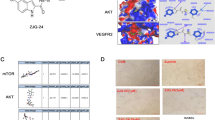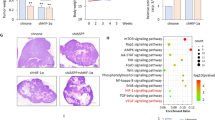Abstract
The hypoxia-inducible factor 1 (HIF-1) plays a critical role for tumour adaptation to microenvironmental hypoxia, and represents an appealing chemotherapeutic target. Silibinin is a nontoxic flavonoid reported to exhibit anticancer properties. However, the mechanisms by which silibinin inhibits tumour growth are not fully understood. In this study, silibinin was found to inhibit hypoxia-induced HIF-1α accumulation and HIF-1 transcriptional activity in human cervical (HeLa) and hepatoma (Hep3B) cells. Neither HIF-1α protein degradation rate nor HIF-1α steady-state mRNA level was affected by silibinin. Rather, we found that suppression of HIF-1α accumulation by silibinin correlated with strong dephosphorylation of mammalian target of rapamycin (mTOR) and its effectors ribosomal protein S6 kinase (p70S6K) and eukaryotic initiation factor 4E-binding protein-1 (4E-BP1), a pathway known to regulate HIF-1α expression at the translational level. Silibinin also activated Akt, a mechanistic feature exhibited by established mTOR inhibitors in many tumour cells. Moreover, silibinin reduced hypoxia-induced vascular endothelial growth factor (VEGF) release by HeLa and Hep3B cells, and this effect was potentiated by the PI3K/Akt inhibitor LY294002. Finally, silibinin was found to be a potent inhibitor of cell proliferation. These results show that silibinin is an effective inhibitor of HIF-1 and provide new perspectives into the mechanism of its anticancer activity.
This is a preview of subscription content, access via your institution
Access options
Subscribe to this journal
Receive 50 print issues and online access
$259.00 per year
only $5.18 per issue
Buy this article
- Purchase on Springer Link
- Instant access to full article PDF
Prices may be subject to local taxes which are calculated during checkout






Similar content being viewed by others
References
Alvarez-Tejado M, Alfranca A, Aragonés J, Vara A, Landázuri MO, del Peso L . (2002). Lack of evidence for the involvement of the phosphoinositide 3-kinase/Akt pathway in the activation of hypoxia-inducible factors by low oxygen tension. J Biol Chem 277: 13508–13517.
Bhatia N, Zhao J, Wolf DM, Agarwal R . (1999). Inhibition of human carcinoma cell growth and DNA synthesis by silibinin, an active constituent of milk thistle: comparison with silymarin. Cancer Lett 147: 77–84.
Bjornsti MA, Houghton PJ . (2004). The TOR pathway: a target for cancer therapy. Nat Rev Cancer 4: 335–348.
Brown JM, Giaccia AJ . (1998). The unique physiology of solid tumors: opportunities (and problems) for cancer therapy. Cancer Res 58: 1408–1416.
Brugarolas J, Lei K, Hurley RL, Manning BD, Reiling JH, Hafen E et al. (2004). Regulation of mTOR function in response to hypoxia by REDD1 and the TSC1/TSC2 tumor suppressor complex. Genes Dev 18: 2893–2904.
Castedo M, Ferri KF, Kroemer G . (2002). Mammalian target of rapamycin (mTOR): pro- and anti-apoptotic. Cell Death Differ 9: 99–100.
Chen PN, Hsieh YS, Chiou HL, Chu SC . (2005). Silibinin inhibits cell invasion through inactivation of both PI3K–Akt and MAPK signalling pathways. Chem Biol Interact 156: 141–150.
Deep G, Oberlies NH, Kroll DJ, Agarwal R . (2008). Isosilybin B causes androgen receptor degradation in human prostate carcinoma cells via PI3K–Akt–Mdm2-mediated pathway. Oncogene 27: 3986–3998.
Fan QW, Knight ZA, Goldenberg DD, Yu W, Mostov K, Stokoe D et al. (2006). A dual PI3 kinase/mTOR inhibitor reveals emergent efficacy in glioma. Cancer Cell 9: 341–349.
Ferrara N . (2004). Vascular endothelial growth factor: basic science and clinical progress. Endocr Rev 25: 581–611.
Fingar DC, Blenis J . (2004). Target of rapamycin (TOR): an integrator of nutrient and growth factor signals and coordinator of cell growth and cell cycle progression. Oncogene 23: 3151–3171.
Giaccia A, Siim BG, Johnson RS . (2003). HIF-1 as a target for drug development. Nat Rev Drug Discov 2: 803–811.
Gu M, Singh RP, Dhanalakshmi S, Agarwal C, Agarwal R . (2007). Silibinin inhibits inflammatory and angiogenic attributes in photocarcinogenesis in SKH-1 hairless mice. Cancer Res 67: 3483–3491.
Guertin DA, Sabatini DM . (2007). Defining the role of mTOR in cancer. Cancer Cell 12: 9–22.
Hanahan D, Folkman J . (1996). Patterns and emerging mechanisms of the angiogenic switch during tumorigenesis. Cell 86: 353–364.
Hockel M, Vaupel P . (2001). Tumor hypoxia: definitions and current clinical, biologic, and molecular aspects. J Natl Cancer Inst 93: 266–276.
Huang J, Dibble CC, Matsuzaki M, Manning BD . (2008). The TSC1–TSC2 complex is required for proper activation of mTOR complex 2. Mol Cell Biol 28: 4104–4115.
Hudson CC, Liu M, Chiang GG, Otterness DM, Loomis DC, Kaper F et al. (2002). Regulation of hypoxia-inducible factor 1alpha expression and function by the mammalian target of rapamycin. Mol Cell Biol 22: 7004–7014.
Jiang BH, Semenza GL, Bauer C, Marti HH . (1996). Hypoxia-inducible factor 1 levels vary exponentially over a physiologically relevant range of O2 tension. Am J Physiol 271: C1172–C1180.
Lah JJ, Cui W, Hu KQ . (2007). Effects and mechanisms of silibinin on human hepatoma cell lines. World J Gastroenterol 13: 5299–5305.
Laughner E, Taghavi P, Chiles K, Mahon PC, Semenza GL . (2001). HER2 (neu) signaling increases the rate of hypoxia-inducible factor 1alpha (HIF-1α) synthesis: novel mechanism for HIF-1-mediated vascular endothelial growth factor expression. Mol Cell Biol 21: 3995–4004.
Manning BD . (2004). Balancing Akt with S6K: implications for both metabolic diseases and tumorigenesis. J Cell Biol 167: 399–403.
Masson M, Willam C, Maxwell PH, Pugh CW, Ratcliffe PJ . (2001). Independent function of two destruction domains in hypoxia-inducible factor-alpha chains activated by prolyl hydroxylation. EMBO J 20: 5197–5206.
Mateo J, García-Lecea M, Cadenas S, Hernández C, Moncada S . (2003). Regulation of hypoxia-inducible factor-1alpha by nitric oxide through mitochondria-dependent and -independent pathways. Biochem J 376: 537–544.
O'Reilly KE, Rojo F, She QB, Solit D, Mills GB, Smith D et al. (2006). mTOR inhibition induces upstream receptor tyrosine kinase signaling and activates Akt. Cancer Res 66: 1500–1508.
Pore N, Liu S, Shu HK, Li B, Haas-Kogan D, Stokoe D et al. (2004). Sp1 is involved in Akt-mediated induction of VEGF expression through and HIF-1-independent mechanism. Mol Biol Cell 15: 4841–4853.
Sabatini DM . (2006). mTOR and cancer: insights into a complex relationship. Nat Rev Cancer 6: 729–734.
Saller R, Meier R, Brignoli R . (2001). The use of silymarin in the treatment of liver diseases. Drugs 61: 2035–2063.
Sarbassov DD, Ali SM, Sengupta S, Sheen J, Hsu P, Bagley A et al. (2006). Prolonged rapamycin treatment inhibits mTORC2 assembly and Akt/PKB. Mol Cell 22: 159–168.
Sarbassov DD, Guertin DA, Ali SM, Sabatini DM . (2005). Phosphorylation and regulation of Akt/PKB by the rictor–mTOR complex. Science 307: 1098–1101.
Schofield CJ, Ratcliffe PJ . (2004). Oxygen sensing by HIF hydroxylases. Nat Rev Mol Cell Biol 5: 343–354.
Semenza GL . (2002). HIF-1 and tumor progression: pathophysiology and therapeutics. Trends Mol Med 8: S62–S67.
Semenza GL . (2003). Targeting HIF-1 for cancer therapy. Nat Rev Cancer 3: 721–732.
Singh RP, Dhanalakshmi S, Agarwal C, Agarwal R . (2005). Silibinin strongly inhibits growth and survival of human endothelial cells via cell cycle arrest and downregulation of survivin, Akt and NF-kappaB: implications for angioprevention and antiangiogenic therapy. Oncogene 24: 1188–1202.
Singh RP, Gu M, Agarwal R . (2008). Silibinin inhibits colorectal cancer growth by inhibiting tumor cell proliferation and angiogenesis. Cancer Res 68: 2043–2050.
Sun SY, Rosenberg LM, Wang X, Zhou Z, Yue P, Fu H et al. (2005). Activation of Akt and eIF4E survival pathways by rapamycin-mediated mammalian target of rapamycin inhibition. Cancer Res 65: 7052–7058.
Thomas GV, Tran C, Mellinghoff IK, Welsbie DS, Chan E, Fueger B et al. (2006). Hypoxia-inducible factor determines sensitivity to inhibitors of mTOR in kidney cancer. Nat Med 12: 122–127.
van den Beucken T, Koritzinsky M, Wouters BG . (2006). Translational control of gene expression during hypoxia. Cancer Biol Ther 5: 749–755.
Varghese L, Agarwal C, Tyagi A, Singh RP, Agarwal R . (2005). Silibinin efficacy against human hepatocellular carcinoma. Clin Cancer Res 11: 8441–8448.
Wang GL, Jiang BH, Rue EA, Semenza GL . (1995). Hypoxia-inducible factor 1 is a basic–helix–loop–helix–PAS heterodimer regulated by cellular O2 tension. Proc Natl Acad Sci USA 92: 5510–5514.
Wang GL, Semenza GL . (1995). Purification and characterization of hypoxia-inducible factor 1. J Biol Chem 270: 1230–1237.
Wellington K, Jarvis B . (2001). Silymarin: a review of its clinical properties in the management of hepatic disorders. BioDrugs 15: 465–489.
Wood SM, Wiesener MS, Yeates KM, Okada N, Pugh CW, Maxwell PH et al. (1998). Selection and analysis of a mutant cell line defective in the hypoxia-inducible factor-1 α-subunit (HIF-1α). Characterization of hif-1alpha-dependent and -independent hypoxia-inducible gene expression. J Biol Chem 273: 8360–8368.
Wright G, Higgin JJ, Raines RT, Steenbergen C, Murphy E . (2003). Activation of the prolyl hydroxylase oxygen-sensor results in induction of GLUT1, heme oxygenase-1, and nitric-oxide synthase proteins and confers protection from metabolic inhibition to cardiomyocytes. J Biol Chem 278: 20235–20239.
Xu Q, Briggs J, Park S, Niu G, Kortylewski M, Zhang S et al. (2005). Targeting Stat3 blocks both HIF-1 and VEGF expression induced by multiple oncogenic growth signaling pathways. Oncogene 24: 5552–5560.
Zhong H, Chiles K, Feldser D, Laughner E, Hanrahan C, Georgescu MM et al. (2000). Modulation of hypoxia-inducible factor 1alpha expression by the epidermal growth factor/phosphatidylinositol 3-kinase/PTEN/AKT/FRAP pathway in human prostate cancer cells: implications for tumor angiogenesis and therapeutics. Cancer Res 60: 1541–1545.
Zhong H, De Marzo AM, Laughner E, Lim M, Hilton DA, Zagzag D et al. (1999). Overexpression of hypoxia-inducible factor 1α in common human cancers and their metastases. Cancer Res 59: 5830–5835.
Zi X, Agarwal R . (1999). Silibinin decreases prostate-specific antigen with cell growth inhibition via G1 arrest, leading to differentiation of prostate carcinoma cells: implications for prostate cancer intervention. Proc Natl Acad Sci USA 96: 7490–7495.
Zi X, Feyes DK, Agarwal R . (1998). Anticarcinogenic effect of a flavonoid antioxidant, silymarin, in human breast cancer cells MDA-MB 468: induction of G1 arrest through an increase in Cip1/p21 concomitant with a decrease in kinase activity of cyclin-dependent kinases and associated cyclins. Clin Cancer Res 4: 1055–1064.
Acknowledgements
This work was supported by grants from ISCIII (FIS03-0924 and FIS07-1168 to JM). PG-M holds a fellowship from the Centro Nacional de Investigaciones Cardiovasculares (CNIC)-Bancaja predoctoral program. CNIC is supported by the Spanish Ministry of Health and Consumer Affairs and the Pro-CNIC Foundation.
Author information
Authors and Affiliations
Corresponding author
Additional information
Supplementary Information accompanies the paper on the Oncogene website (http://www.nature.com/onc)
Rights and permissions
About this article
Cite this article
García-Maceira, P., Mateo, J. Silibinin inhibits hypoxia-inducible factor-1α and mTOR/p70S6K/4E-BP1 signalling pathway in human cervical and hepatoma cancer cells: implications for anticancer therapy. Oncogene 28, 313–324 (2009). https://doi.org/10.1038/onc.2008.398
Received:
Revised:
Accepted:
Published:
Issue Date:
DOI: https://doi.org/10.1038/onc.2008.398
Keywords
This article is cited by
-
Effects of HIF-1α on Spermatogenesis of Varicocele Rats by Regulating VEGF/PI3K/Akt Signaling Pathway
Reproductive Sciences (2021)
-
Immunoregulatory Effects of Silymarin on Proliferation and Activation of Th1 Cells Isolated from Newly Diagnosed and IFN-ß1b-Treated MS Patients
Inflammation (2019)
-
Intravitreal Ets1 siRNA alleviates choroidal neovascularization in a mouse model of age-related macular degeneration
Cell and Tissue Research (2019)
-
Novel insights into the effect of vitamin B12 and omega-3 fatty acids on brain function
Journal of Biomedical Science (2016)
-
Suppression of c-Myc induces apoptosis via an AMPK/mTOR-dependent pathway by 4-O-methyl-ascochlorin in leukemia cells
Apoptosis (2016)



